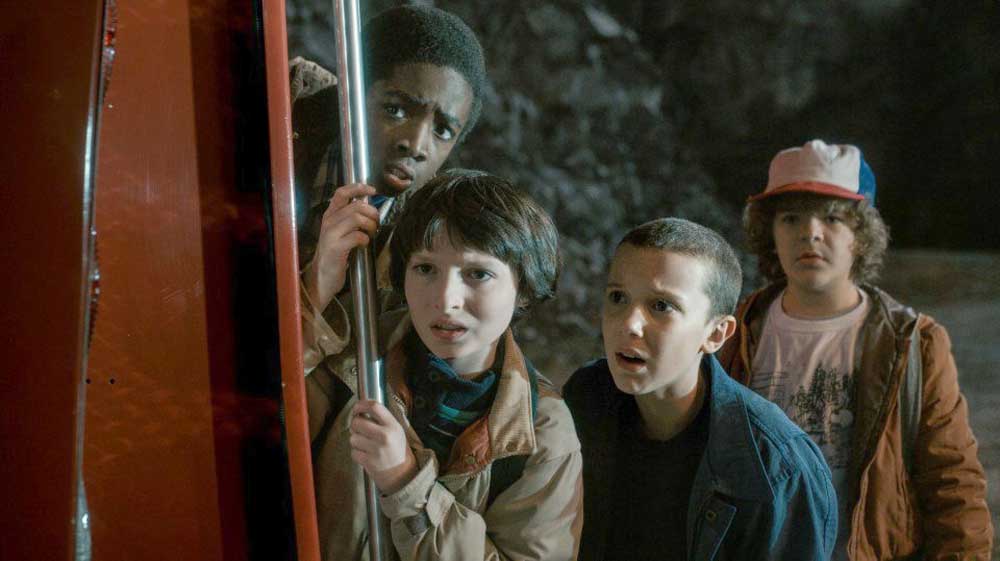Netflix shows rethink thrills of yesterday
Published 12:00 am Tuesday, August 30, 2016

- Netflix / Submitted photoA group of friends searches for a lost boy in Netflix’s nostalgic thriller “Stranger Things.”
Nostalgia is too big a force in pop culture to belong to any one institution. But Netflix owns a bigger percentage of it than most, simply because the past is built into its business model.
“If you liked that, you’ll like this” is the watchword of the streaming service’s algorithm. But it’s also the essence of cultural nostalgia: the longing to find some “this” that reproduces the cherished pleasures of some long-ago “that.”
As Netflix has shown us, there are different ways to chase the thrills of yesterday. You can reboot it, as when “Fuller House” brought the characters of “Full House” into 2016. You can revive it, as with the coming continuation of “Gilmore Girls.”
Or — as in Netflix’s two throwback shows of the summer, “Stranger Things” and “The Get Down” — you can rethink it.
Neither of them — unlike this year’s “The X-Files” or “Ghostbusters” — is based on an existing franchise. They tickle our memory centers without inviting unflattering comparisons to some sainted original. They might succeed or not, but they’re at least trying to reproduce part of what made us love our childhood favorites way back when: the joy of discovering something for the first time.
With “Stranger Things,” Matt and Ross Duffer have made something you might imagine coming from child prodigies who grew up in an abandoned Blockbuster full of VHS tapes, a monster sewn from pieces of Steven Spielberg, Stephen King, Wes Craven and more.
Part of the series’ pleasure is how well it re-creates the details not only of life in 1983 but also of storytelling in 1983, from the synth music to the Benguiat typeface of the title credits. (This was also the mode of “Red Oaks” on Amazon and Netflix’s “Wet Hot American Summer: First Day of Camp.”) It even cast Winona Ryder, star of the 1988 “Heathers,” in the same talismanic way that Quentin Tarantino recruited the 1970s icon Pam Grier for the blaxploitation-inspired “Jackie Brown.”
In its individual pieces, “Stranger Things” is an Easter-egg salad of references, storylines and tropes. What elevates the series is the way it looks back on its inspirations with the benefit of hindsight. (Or at least secondhand hindsight: the Duffers, twin brothers, were born in 1984, a year after the season takes place.) The vintage artifacts are scuffed, some of the Spielbergian glow rubbed off. Its Indiana hometown feels a little rusty and dangerous, even before the monster and wicked scientists turn up.
“Stranger Things” isn’t revolutionary — it’s a tasty campfire s’more, the kind of summer movie that the actual summer movie season didn’t provide. But it manages to deliver on the appeal of nostalgia — the allure of simpler, innocent times — while letting on that it realizes those times were neither simpler nor more innocent.
“The Get Down” performs the opposite trick: It takes a period fixed in popular history as a nadir and turns it into a moment shimmering with possibility.
From Spike Lee’s “Summer of Sam” to the ESPN miniseries “The Bronx Is Burning” (based on a book by The New York Times’ Jonathan Mahler), 1977 has been portrayed as the year New York City bottomed out. “The Get Down,” a fanciful origin story of hip-hop in the Bronx, presents it as the year a new urban culture impossibly took flight.
Part of this is the influence of the creator Baz Luhrmann, who has never met a subject he wouldn’t blast with a glitter cannon. The sensibility of “The Get Down” is defiantly joyous, more “The Wiz” than “The Warriors.” There may be arson-torched apartment buildings and gaudily art-directed murders, but the series’ true love is for orange limousines and tight, bumping disco pants.
The show’s stylistic pastiche is less blatant than those in “Stranger Things,” but it even more forcefully wrestles with the popular conception of its setting. Where we expect to see problems, it sees opportunities — chances for invention and self-invention, even if it takes struggle.
Compared with HBO’s somber and now-canceled 1970s music drama, “Vinyl,” “The Get Down” is mainly a young people’s story. It refuses to be pessimistic, and it’s cast with vibrant young actors like Justice Smith and Herizen Guardiola, whose performances each contain a full day’s supply of vitamin C.
Like “Stranger Things,” with its brick-size walkie-talkies, “The Get Down” fetishizes predigital technology (here, turntables and crayon-marked LPs) as a means of liberating ingenious kids. Midseason, the Bronx is hit by the notorious blackout of 1977, whose chaos and looting got record players and mixing boards into the hands of the youth, written off, who will help create an American art form.
“Stranger Things” is much more fully formed. “The Get Down” is plagued by an undisciplined ambition to be every story — melodrama, history, romance, musical comedy, political intrigue. It has electric moments, but only becomes focused intermittently, in the last couple hours of its six-episode initial run.
But both shows are encouraging examples of how to use nostalgia for more than cheap hits of “Remember that?” Not unlike the DJs of “The Get Down,” they practice a kind of scavenger’s art, weaving samples and familiar hooks into kinetic new rhythms. There’s no shortage of TV that invites us to relive the past, but it can be much more rewarding to remix it.






